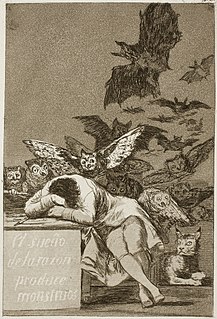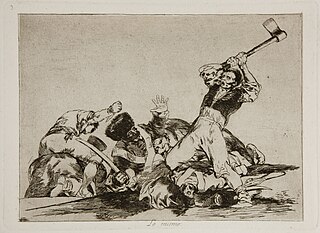 W
WLos caprichos are a set of 80 prints in aquatint and etching created by the Spanish artist Francisco Goya in 1797 and 1798, and published as an album in 1799. The prints were an artistic experiment: a medium for Goya's condemnation of the universal follies and foolishness in the Spanish society in which he lived. The criticisms are far-ranging and acidic; he speaks against the predominance of superstition, the ignorance and inabilities of the various members of the ruling class, pedagogical short-comings, marital mistakes and the decline of rationality. Some of the prints have anticlerical themes. Goya described the series as depicting "the innumerable foibles and follies to be found in any civilized society, and from the common prejudices and deceitful practices which custom, ignorance or self-interest have made usual".
 W
WThe Disasters of War is a series of 82 prints created between 1810 and 1820 by the Spanish painter and printmaker Francisco Goya (1746–1828). Although Goya did not make known his intention when creating the plates, art historians view them as a visual protest against the violence of the 1808 Dos de Mayo Uprising, the subsequent Peninsular War of 1808–1814 and the setbacks to the liberal cause following the restoration of the Bourbon monarchy in 1814. During the conflicts between Napoleon's French Empire and Spain, Goya retained his position as first court painter to the Spanish crown and continued to produce portraits of the Spanish and French rulers. Although deeply affected by the war, he kept private his thoughts on the art he produced in response to the conflict and its aftermath.
 W
WLos disparates, also known as Proverbios (Proverbs) or Sueños (Dreams), is a series of prints in etching and aquatint, with retouching in drypoint and engraving, created by Spanish painter and printmaker Francisco Goya between 1815 and 1823. Goya created the series while he lived in his house near Manzanares on the walls of which he painted the famous Black Paintings. When he left to France and moved in Bordeaux in 1824, he left these works in Madrid apparently incomplete. During Goya's lifetime, the series was not published because of the oppressive political climate and of the Inquisition.
 W
WThe Sleep of Reason Produces Monsters is an aquatint by the Spanish painter and printmaker Francisco Goya. Created between 1797 and 1799 for the Diario de Madrid, it is the 43rd of the 80 aquatints making up the satirical Los Caprichos.
 W
WLa Tauromaquia (Bullfighting) is a series of 33 prints created by the Spanish painter and printmaker Francisco Goya, which was published in 1816. The works of the series depict bullfighting scenes. There are also seven extra prints that were not published in the original edition.
 W
WThis is worse is an etching and wash drawing by the Spanish artist Francisco Goya (1746–1828). Completed between 1812–1815, though not published until 1863, it forms part of his Disasters of War series, which Goya created as a visual protest against the violence of the 1808 Dos de Mayo Uprising and subsequent Peninsular War of 1808–1814.
 W
WUnfortunate Events in the Front Seats of the Ring of Madrid, and the Death of the Mayor of Torrejón is the name given to an etching with burnished aquatint, drypoint and burin on paper by the Spanish painter and printmaker Francisco Goya.